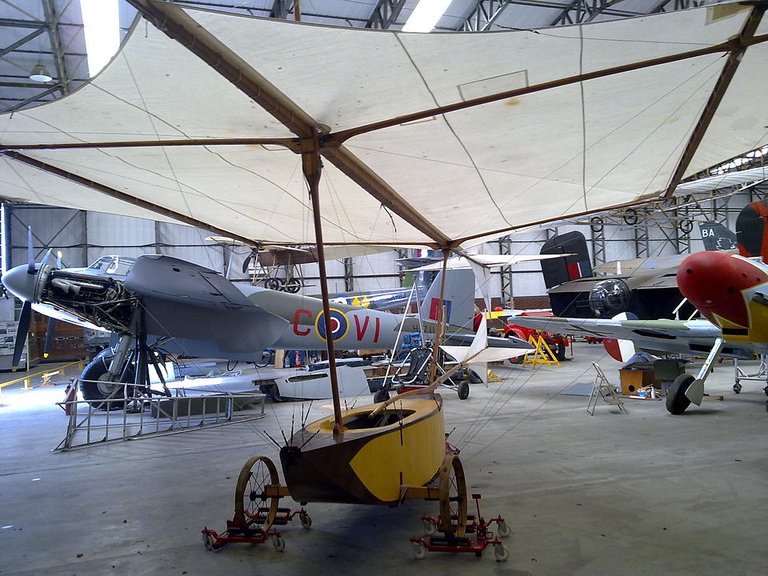
I wrote a post recently about Thornton-le-Dale in which I extolled the virtues of my county of birth in the UK which is well known to be God's finest and most favourite part of his creation during his six-day DIY spree just a few thousand years ago and so I have decided to write a series of posts to prove to everyone, once and for all that Yorkshire has given more gifts to humanity than any other area of the world, and yes. I really am starting with aeroplanes!
Now I can almost hear the guffaws of laughter and screams of 'fake news' from here on my small idyllic island in the Gulf of Thailand, but hear me out, consider the facts, and I promise you that by the end of this article, you too will have reconsidered everything you thought you knew about air travel.
Now I know at this point, you'll still be banging on about those two American grease monkeys, Orville and Wilbur Wright and to give credit where its due, they were the first to build and make a successful flight in a powered aircraft which was back in December 1903, just over 121 years ago but to have the knowledge and understanding of aeronautics to be able achieve this, they have a Yorkshireman to thank. That Yorkshireman was George Cayley, who was born in my beloved town of Scarborough, on the 27th of December 1773, long before the Wright brothers were even a twinkle in their parent's eyes.

Sir George Cayley source
George was an engineer, inventor and possibly the world's first Av Geek. He was the first person to identify the forces that would act upon an object that was heavier than air and allow it to fly. As any high school pupil could tell you, those forces are weight, lift, drag and thrust, and he'd designed a basic flying machine and drawn it on a silver plate as early as 1799. Using this knowledge and hundreds of models and tests, he went on to develop the modern, cambered wing shape that changes the speed of air across its upper and lower surfaces to create lift. Up until this point, everyone trying desperately to build flying machines, and even after, were still aiming to mimic the flight of birds and insects by using wings that flapped to create lift and it was George's realisation that there was no way it was possible to build wings that could have enough surface area and be flapped fast enough to be able to take off that truly shows the genius of his new, cambered wing and principles of lift.
George was also a realist and knew that it would take an as yet un-invented and lightweight engine to provide sustained forward motion and compliment his wing's vertical, lifting forces and the development of lightweight internal combustion engines was another field in which he 'dabbled' throughout his life.
All this knowledge was written down and published as a three-part essay entitled 'On Aerial Navigation' in Nicholson's Journal of Natural Philosophy in 1809.
Most importantly, however, he built the first aircraft, a glider that was able to carry a man and fly. This is why, in scientific circles, George is commonly known as the father of aeronautics.
So in 1804, George built an unmanned glider that flew unaided, both proving and reinforcing his principles of flight as well as becoming officially, the world's first glider. Strangely though, he appeared to get a bit bored with flying and it wasn't until an unknown time before 1849 that he built a full scale gliding bi-plane that after trials using ballast allegedly carried a 10 year-old boy, the son of one of his servants through the air across Brompton Dale, in Yorkshire. Don't worry, kids of that age were working down coal mines and up chimneys back in the day so this kid was lucky to fly, and probably never realised its significance as it was many more years before package holidays to Benidorm by air became a thing!

'The boy carrier' triple horizontal winged glider original design. source
Now if you're wondering if he was simply taking a break and sat tossing it off on the beach at Scarborough eating ice cream and playing the slot machines, you couldn't be more wrong. He was busy inventing stuff. Stuff like seatbelts, tensioned spoked wire wheels, self-righting life boats, automatic railway signals and an internal combustion engine that used gunpowder! He did however, correctly suggest, that engines would be better running on a' gaseous vapour' thus predicting the modern internal combustion engine, over 20 years before it became a thing!

See these beautiful spoked wheels from an E-Type Jaguar? George invented them! source
Finally, in 1853, along with his grandson and assistant engineer, Thomas Vicks, and using his lifetime of research and knowledge, completed his full size winged glider, big enough to carry a fully grown man which made a successful flight of a reported 900 feet, again, across Brompton Dale and in front of his family's ancestral home, Wydale Hall.
"Bugger me!" George exclaimed with excitement (possibly!) as his flying machine soared majestically into the air, before his Yorkshire upbringing restored him to his usual, stoic yet quietly satisfied demeanor.
I say successful flight as it did properly fly for 900 feet...right up until the time it crashed into the ground. No reports are to be found anywhere about the fate of its 'pilot' but let's be optimistic and assume he survived with a bumped head that was fixed using vinegar and brown paper!

A flying replica of the 1853 glider, the first aeroplane to carry an adult, which now resides at the South Yorkshire aircraft museum. By Nigelcoates at English Wikipedia, CC BY-SA 3.0, https://commons.wikimedia.org/w/index.php?curid=7409647
Who cares about the landing anyway? This was absolutely the first ever recorded flight of an adult in an aircraft.
Who the pilot was, or most likely, petrified 'volunteer' who just sat and 'enjoyed' the ride, isn't truly known but a couple of suggestions put forward were that it may have been a member of his household staff or a member of his engineering team. Either way, old George, our shrewd Yorkshire hero wasn't daft enough to get in the contraption itself. That would have been 'bloody dangerous'! If he'd been killed, the world would never have had Hong Kong Airport or any of the other airports and infrastructure that rely on land reclamation as in the final few years of his life, pioneered and assisted in that field too, using his knowledge of aeronautics and applying it to forces acting on fluids.
Sir George Cayley died in 1857 and was buried close to his home at All Saints church at Brompton-in Sawdon. I'm not sure he achieved enough acclaim for his amazing contributions to science, engineering and particularly, flight during his life. However, since his death, in more recent times, there appears to be a growing movement recognising his career and work and celebrating his incredible achievements.
Orville and Wilbur however did recognise the fact that he'd paved the way for them when in 1909, Wilbur Wright said,
"About 100 years ago, an Englishman, Sir George Cayley, carried the science of flight to a point which it had never reached before and which it scarcely reached again during the last century."

Sorry, wrong picture...

The Wright Brothers source
A replica of the of the glider was built in 2003 by BAE systems, part of Airbus and sponsored by Virgin Atlantic to celebrate the 150th anniversary of the flight. First tested at Pocklington aerodrome near York (also in Yorkshire) before being transported to the original site at Brompton and flown by none other than Sir Richard Branson on July 5th 2003. After this, it was taken on a world tour by Virgin before finally finding a home at the South Yorkshire aircraft museum where it can still be viewed today.
I think that’s a fitting tribute to old George’s work and finally provides all the evidence needed that Yorkshire, truly did invent aeroplanes!
I hope you enjoyed reading this as much as I did researching and writing it. There will be more Yorkshire ‘firsts’ to come in the future but for now, thanks for reading and dropping by and my best wishes to all.
Martin
Great story, I remember the bbc covering this years ago, but couldn’t remember the man’s name. Being a fellow Yorkshireman it certainly got me interest.
I'd not heard of him to be honest and I never realised you had an aircraft museum down your way. As a matter of interest, what happened to Sheffield Airport?
Excuse the pun, but it never took off lol. It’s know full of buildings so won’t reopen as an airport again.
Loool that was a cheeky one (I meant the bird image) in place of the wright Brothers.
I mean, in the case of Cayley, I think most original initiative inventors are forgotten, simply because someone came up and finishing building on the foundations of the original inventors. It's a harsh thing
Lol...Well, the white bird is a Disney character called Wilbur and the green duck is famous in the UK as its a ventriloquists dummy called Orville so there was a link!
And you're absolutely correct. So many people did the groundwork for many things we take for granted and others got all the plaudits.
Had a coke recently? Ever wondered who invented the technique for putting bubbles into drinks? ....another Yorkshireman!
Have a great weekend mate and thank you so much :-)
Thanks for your contribution to the STEMsocial community. Feel free to join us on discord to get to know the rest of us!
Please consider delegating to the @stemsocial account (85% of the curation rewards are returned).
You may also include @stemsocial as a beneficiary of the rewards of this post to get a stronger support.
Thank-you very much. I hadn't realised there was still an active community.
Best wishes to your team :-)
Hopefully he took a couple of months off to toss himself off by the beach over the years.
Thoroughly enjoyable read!
Thank you so much. A proper compliment. All I wanted to do was give a fun factual read. It's amazing when you look around, the connections and stories behind stuff we take for granted.
Have a great weekend, fella :-)
Sending Love and Ecency Curation Vote!
 Follow Eceny's curation trail to earn better APR on your own HP. : )
Follow Eceny's curation trail to earn better APR on your own HP. : )
@untilwelearn thank you to you and the whole gang at @ecency. Your support is very much appreciated :-)
I was at Bristol Aerospace the other year and read about a Bristolian who tried to build things to fly in the old days, can't remember if he got as far as building an aircraft like good ole George.
Btw, I nearly need an oxygen tank after reading your opening paragraph 😂

Haha Check the edit history, I posted it by mistake again when trying to save a draft so had to try and finish after posting....it's still a work in progress ;-)
This post is great. I had never heard of George Cayley and yet he was a very important engineer for modern aeronautics. Thanks for mentioning him
Congratulations @nathen007! You have completed the following achievement on the Hive blockchain And have been rewarded with New badge(s)
Your next target is to reach 13000 replies.
You can view your badges on your board and compare yourself to others in the Ranking
If you no longer want to receive notifications, reply to this comment with the word
STOPCheck out our last posts: